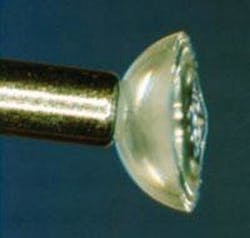Solid-immersion lenses take data capacity to the next level

Optical-storage and playback technology has progressed in leaps and bounds—and very even ones, at that. Each new version of the optical disc has held five to seven times as much information as its predecessor: from the 0.7-Gbyte capacity of CDs, to the 4.7-Gbyte capacity of DVDs, to the 25-Gbyte capacity of Blu-ray discs. Now, even as the shelves of local consumer-electronics stores await the eventual coming of Blu-ray players and recorders (or perhaps their HD-DVD rivals), researchers at Royal Philips Electronics (Eindhoven, The Netherlands) are engineering the next factor-of-six advance.
In presentations given at the Optical Society of America’s International Symposium on Optical Memory and Optical Data Storage (July 10-14, Honolulu, HI), Philips researchers outlined their latest achievements in the near-field recording technique chosen by the company as the most likely next step in optical-disc technology.
The researchers described two systems, one containing an objective lens with a numerical aperture (NA) of 1.9 designed to work with bare discs (those with data recorded on their top surfaces) and another operating at an NA of 1.45 intended for use with discs protected by a cover layer.1, 2 Both versions are based on Philips’ solid-immersion-lens (SIL) technology, in which the last lens element in the read/write objective is held at a distance of a few tens of nanometers above the surface of the disc, allowing the entire NA of the lens to focus on the disc just as if there were no air space between the lens and disc (ordinarily, an air space between a lens and image precludes the use of an NA greater than 1). The systems operate in the open air, eliminating the need for clean-room equipment or environmental sealing.
The Philips researchers aim to record and read 150 Gbytes of information on a single DVD-size disc in a commercially viable manner. This disc could have a cover layer or could be bare, and it could have a single recording layer or two closely spaced layers, each accessed by a change in lens focus depth. The 1.45-NA lens would record 75 Gbytes in two layers, while the 1.9-NA version would record the entire 150 Gbytes in a single layer.
Small gap is OK
The 1.9-NA solid-immersion aplanatic element is designed to work at a 25-nm distance from the disc and has a refractive index of 2.08 at the 405-nm design wavelength. Although 25 nm sounds minuscule, it is about the same gap at which computer hard-disc heads operate. “Due to the very small distance between lens and disc, mechanical tolerances require a flatness to around ±25 µm,” says Coen Verschuren, one of the researchers. “Specifications for Blu-ray discs are somewhat less strict, but Blu-ray disc substrates produced today easily meet our requirements. This indicates that current technology is already sufficient. Obviously, improved flatness and tighter tolerances would further improve system performance, notably at high rotation speeds.”
The thickness tolerance is very tight for the element and needs to be held to better than 0.2 µm. The element is hyperhemispherical; its disc-side surface is a shallow cone with a 30-µm-diameter flat at its center. A nonperiodic phase structure similar to a Fresnel zone plate can be placed elsewhere in the objective to control chromatic aberration-although a blue laser diode is monochromatic, its wavelength shifts as it changes power from read to write modes. Polarization effects increase at high NA; the researchers had to take these effects into account when designing the lens and measuring its aberrations.3
A gap-error signal derived from the light reflected from the disc and sampled at 600 kHz drives a focus-and-tracking actuator servo, and a so-called memory-loop control scheme further reduces gap error. Preliminary read-out results at a track pitch of 160 nm show good results, although the experiment is far from optimized.
Perhaps more important for future commercial systems is the cover-layer-compatible 1.45-NA version (see figure). Here, the disc has a 3-µm-thick polymer cover layer; the hemispherical SIL has a 10-µm thickness tolerance that is amenable to commercial fabrication techniques, and operates at a 40-nm distance from the disc. The first read-out experiments were carried out on a prerecorded disc with track pitches ranging from 140 to 200 nm, mastered using a liquid-immersion technique (the ultimate capacity of the near-field system is substantially greater than that of the test disc). A clear eye pattern was read at a 170-nm track pitch.
REFERENCES
1. C. A. Verschuren et al., ISOM/ODS 2005, paper WD4.
2. C. A. Verschuren et al., ISOM/ODS 2005, paper WD2 (invited).
3. F. Zijp et al., ISOM/ODS 2005, paper WD5.
About the Author
John Wallace
Senior Technical Editor (1998-2022)
John Wallace was with Laser Focus World for nearly 25 years, retiring in late June 2022. He obtained a bachelor's degree in mechanical engineering and physics at Rutgers University and a master's in optical engineering at the University of Rochester. Before becoming an editor, John worked as an engineer at RCA, Exxon, Eastman Kodak, and GCA Corporation.
